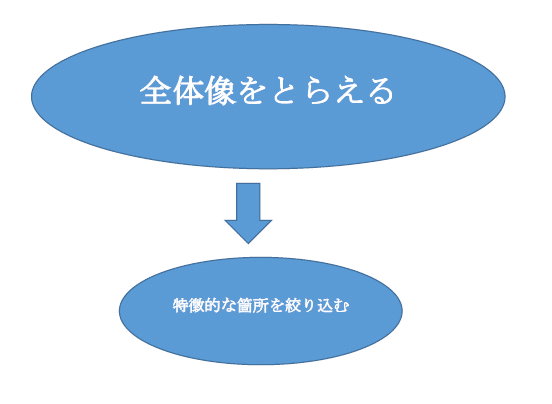
[IELTS Academic Writing #4] Task1の総括アドバイス編
今回はIELTSのTask1の総括編。なお、今回の記事は以下の4本の記事の総集編(模範解答あり)となる。
1)IELTS(アイエルツ)を勉強する前に知っておきたい大切なこと(初めに)
2)[IELTS Academic Writing #1 ]まず知っておきたいこと
3)[IELTS Academic Writing #2 ] Task1導入部
4)[IELTS Academic Writing #3 ] Task1本体
「どうやってTask1でより高い点数をとれるようにするか」のコツ
コツ1:明確で詳細な導入部を書く (クラフの2軸、何のグラフ、いつ、どこで、誰が調査対象の全ての情報を含める)
コツ2:本体の描写の順番
2-1:まずグラフの全体像(トレンド)を描写 (その際、%などの具体的な数字はいれない)
2-2:その全体像を数字を入れて描写
2-3:特徴的な箇所を絞り込んで描写
<本体のイメージ>

コツ3:語威力が高いことを示すこと! その方法は、
[方法1]異なる動詞や名詞を使う(同義語・類義語)(例えば下の例)
上昇する表現(動詞/名詞)
• rise/a rise
• increase/ an increase
• climb/ a climb
• grow/ a growth
下降する表現(動詞/名詞)
• decrease/ a decrease
• drop/ a drop
• fall/ a fall
• decline/ a decline
他の役にたつ表現
• fluctuate/ a fluctuation(動詞/名詞)
• remain steady
• remain stable
• remain unchanged
• peak at
• reach a peak of
• hit a high of
• hit a low of
• bottom out
• plateau
[方法2]様々な形容詞や副詞を使う
副詞(副詞は動詞を修飾するので単独で動詞の前後につける) steadily, gradually, sharply, rapidly, slightly, drammatically, significantly, considerably等
形容詞(形容詞は名詞を修飾するので名詞の前につけるか、Be動詞やkeep やremainの後(SVCの構文)につける) steady, gradual, sharp, rapid, slight, dramatic, significant, considerate等
[方法3]様々な時間表現を使う(例えば下のように具体的な数字以外で時を表現できる)
時間表現
• over the next X days
• X days later
• in the following X days
• the next X days
• over the period
• from A to B/ between A and B
• the last year
• the final year
• the first year
• at the beginning of the period
• at the end of the period
コツ4:150語以上を絶対に書くこと(目標は160語から190語)
コツ5:Task1に20分以内で終わらせること
コツ6:読者が理解しやすいように、本体を論理的に組み立てること
コツ7:文法や単語の間違いをなるべくしないようにすること
コツ8:絶対自身の意見や見解は書かないこと
これらのコツを参考にして、私自身もこのTask1に取り組んだ(下)
The graph shows the percentage of over four years old audiences who were on radio or television through the day during the period October-December 1992 in the UK.
Over the whole time period, there was a slight fluctuation in the percentage of radio audience with the peak at 8:00 am, while the television audience percentage peaked 8:00pm.
The percentage of radio audience increased rapidly to a peak at 30% at 8:00am and then went into a gradual decline to 0% at 2:00am. In comparison, the television audience increased by 20 % from 6:00 to 2:00pm, followed by a further sharp increase to a peak 40 % at 8:00pm. After 8:00pm they dropped dramatically to 0% at 2:00am. Interestingly both radio and TV had an equal audience share of 20% at 2:00pm and both radio and television had very little viewers after 2:00 am.
To conclude, radio had a higher audience in the morning, whereas television was more popular between 2:00pm and midnight. (162 words)
(作文は筆者自身作で文法は英語ネイティブがチェック済み)無断転写禁止
第一段落(導入部) 動詞の時制は「現在形」で与えられた全ての情報を網羅。
第二段落(本体の全体像の要約) 全体のトレンドを描写し、具体的な数字は入れない:読者にまず全体像を理解してもらう目的。動詞の時制は「過去形」
『表現のポイント』Over the whole time periodで時間を表現し、whileを使い二つのグラフを対比し、peakの動詞・名詞両方使いをした。
第三段落(全体像を数字で具体的に説明:冒頭写真の黄色く○した箇所) 特徴となる箇所を二つ選びそれを対しながら描写した。(学術論文ではこの特徴となる結果を使って、次の章(Discussion)で過去の文献を入れ込みながら議論していく)
『表現のポイント』読者の興味を引くように表現の仕方に「ストーリー性」を盛り込んだ。特に In comparison, followed by(andの多用を避けれる表現でよく使う)、Interestingly、very littleなどの表現でリズムのある作文にした。そして、audienceの連続使いを避けるため、viewerを使った。
第四段落(最後のまとめ:IELTSではオプッション) 第二段落の言い換えになるが、全く同じ方法でまとめないで、パラフレーズのテクニックを使った。パラフレーズはアカデミックライティングやスピーキングでは絶対に必要なスキル。
『表現のポイント』リズムのある文にするため、対比構文(whereas)や接続副詞(To conclude)をつかった。
以上がTask1のアドバイス。私自身のIELTS受験や大学院時代の学術論文出版の経験から、5回にわたって書いてきたが、これらの記事が、少しでもIELTSを受験する方たちの何かの助けになれたら幸いだ。
この情報は英語資格試験や英語で論文を書いている人たちだけでなく、ビジネスマンが、英語でプレゼンする時、聞き手を飽きさせないで、論理的に説明する際にも使えるテクニックだと思う。
この記事が気に入ったらサポートをしてみませんか?
